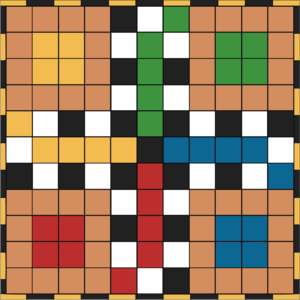Haeseni Chess
| ||||||||||||||||
Haeseni Chess is a Haeseni board game, created by Robert I of Haense in 1678.
The game was established in the city of Markev and has over the years spread to be played by humans all over the Holy Orenian Empire and can be found in places such as Helena, Adria and was even found to be played by Norlanders living in Dunharrow.
Rules
The game can be played by 2, 3 or 4 players – one player per board side. Each player has four game pieces, which are in the "out" area when the game starts, and which must be brought into the player's "home" row.
The rows are arranged in a cross position. They are surrounded and connected with a circle of fields, over which the game pieces move in clockwise direction. There are three fields on each side of the board. At the beginning of the game, the players' pieces are placed in the four fields marked "B" on the far left side, the "out" section. The coloured field just left of centre, marked "A", is each player's "start" field. The white filed just to the right of the start field leads to the "home" row, marked "a", "b", "c", "d". Each game piece enters the circle at the "start" field ("A"), moves (clockwise) over the board and finally enters the "home" row. The first player with all of their pieces in their "home" row wins the game.
The players throw a dice in turn and can advance any of their pieces in the game by the thrown number of dots on the dice.
Throwing a six means bringing a piece into the game (by placing one from the "out" ("B") area onto the "start" or "A" field) and throwing the dice again. If a piece is on the "A" field and there are still pieces in the "out" area, it must be moved as soon as possible. If a piece cannot be brought into the game then any other piece in the game must be moved by the thrown number, if that is possible. A commonly played variation allows a player who has no pieces in the circle of fields to have three tries to throw a six.
Pieces can jump over other pieces, and throw out pieces from other players (into that player's "out" area) if they land on them. A player cannot throw out his own pieces though, he can advance further than the last field in the "home" row. A player can be thrown out if he is on his "start" field.
